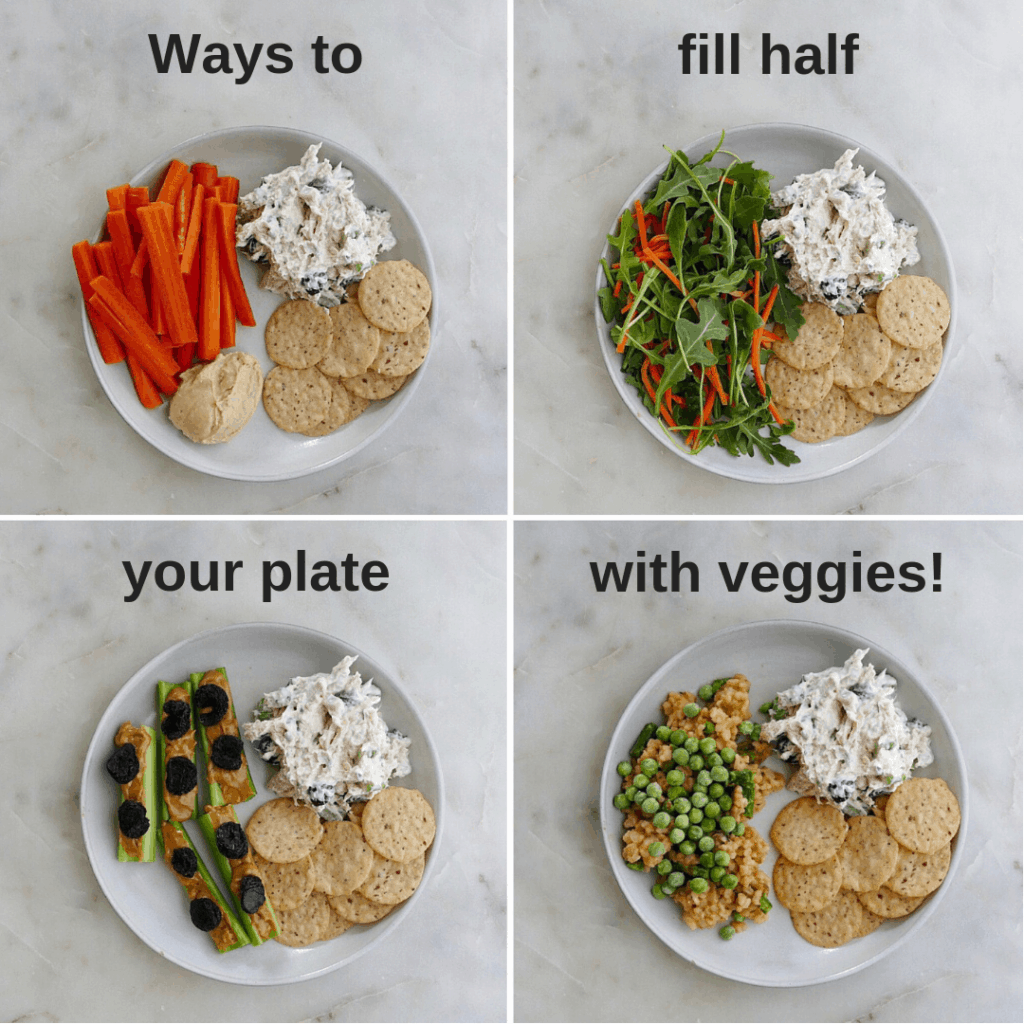Learn how you can translate the advice to fill half your plate with veggies into practice!

This post may contain affiliate links. For more information, see my affiliate disclosure.
I’m assuming you’ve heard it before – the general recommendation to make half your plate veggies?
As a dietitian and veggie enthusiast, I’ve given this advice more times than I can count. Mainly because I think it makes sense. It’s practical. It’s approachable. It makes healthy eating fun and visually appealing. Right?
But what if it isn’t as approachable as all of us nutrition experts think? Sure, the concept of dividing your plate, filling one half with veggies, a quarter with carbs, and another quarter with protein (plus some healthy fats in there) is pretty easy to grasp.
Most people also understand why this recommendation exists. Vegetables are the backbone of a healthy diet, and they’re loaded with vitamins, minerals, fiber, and beneficial plant compounds (1).
In fact, it’s pretty common knowledge that a diet rich in vegetables has been associated with lower risks of heart disease, obesity, and some cancers (2, 3, 4).
But the part where you actually put “eat more vegetables” into practice? That’s where it can start to get difficult.

Tips to Help You Fill Half Your Plate with Veggies
There can be so many reasons why it’s hard to make veggies the backbone of most of your meals. Things like limited cooking skills and finances, lack of time, and food preferences present real challenges to eating vegetables.
Even if you are someone who likes to cook and eat nutritious foods, it’s easy to get stuck in a rut and become bored with the ways you prep veggies.
So to make it easier for you to think outside the box to include veggies at most of your meals, I’ve put together my favorite tips!
1 – Give raw, chopped veggies a boost with a good dip.
Not that I have anything against carrots and hummus, but if that’s the only way you like to eat veggies, it can get old REAL fast.
Still, chopped veggies with dip is a great, low maintenance option for those who don’t have much time/desire to cook or need a healthy snack on the go. Here are a few ways to mix up this classic combo:
- Chopped bell peppers and guacamole
- Ants on a log with celery sticks, peanut butter, and raisins or dried tart cherries
- Radishes and plain Greek yogurt mixed with lemon juice and dill
- Zucchini and whipped feta dip
- Jicama and avocado mashed with chili powder and lime
- Carrots and Caramelized Onion White Bean Dip or Roasted Turnip Hummus (bonus veggies IN those dips!)
2 – Jazz up your salads.
It goes without saying that salads are one of the easiest ways to fill half your plate with veggies. But most of the time our salads are hardly reaching their full potential.
Here are some of my favorite “jazzed up” salads that can be a full meal or side:
- Salads that can be a meal: Maple Swiss Chard Salad with Turkey; Greek salad with romaine, tomatoes, cucumbers, feta, and chickpeas; Southwest salad with beans, guacamole, salsa, radishes, and cheese
- Yummy side salads (add a protein to any of these for a more complete meal): Sweet Corn and Cherry Arugula Salad, Fig and Barley Arugula Salad, the Best Chopped Kale Salad with Tahini Dressing

3 – Try veggies mixed into recipes, instead of as a side.
There are countless vegetable side dishes out there (including those in my Veggie Recipe Library), but you can easily mix it up and enjoy veggies incorporated into recipes instead.
Vegetables can be blended into sauces, baked into frittatas and casseroles, mixed into burgers and meatloafs, put into muffins and breads, added to oatmeals, mixed into chicken or tuna salad, used in risotto or other grain dishes, and more.
Some of my favorite recipes with mixed in veggies include:
- Vegetarian Meal Prep Breakfast Sandwiches
- Zucchini Carrot Oat Muffins
- Sweet Potato Black Bean Patties
- Mini Cucumber Sandwiches with Herbed Cream Cheese
- Carrot and White Bean Vegan Blondies
- Slow Cooker Black Beans with Scallions
- Veggie Slow Cooker Mexican Chicken
4 – Experiment with spiralized and riced veggies.
Tired of veggies in their typical shape? Mix it up with spiralized or riced varieties.
You can purchase premade veggie “noodles” or “rice” at most grocery stores, in the fresh or frozen section. Or you can use a spiralizer or food processor to make them at home.
Use veggie noodles as the base for a new recipe, like my Spiralized Golden Beet Salad, or serve a chicken or bean dish over riced cauliflower.
5 – Prep veggie-based soups in bulk to have on hand.
Soups are excellent vehicles for veggies. You can easily use a side of vegetable soup to fill half your plate with veggies.
Prepare soups in bulk to reheat and enjoy all week long, or store them in the freezer when you need veggies in a pinch.
Some of my favorite veggie-loaded soups include:
- Healthy Vegetable Tortellini Soup
- Butternut Squash and Pear Soup
- Parsnip and Pear Blender Soup
- Celeriac and Green Apple Soup

Making veggies half of your plate can be challenging, but it doesn’t have to be. Start small by filling most of your plate with veggies at one meal per day.
When you’re ready to add veggies to your other meals, follow some of the tips in this list!
Happy veggie eating,
Lizzie





Comments
No Comments